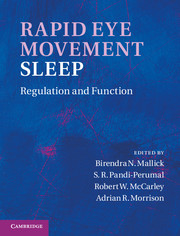Book contents
- Frontmatter
- Contents
- Contributors
- Preface
- Acknowledgments
- Organization
- Section I Historical context
- Section II General biology
- Section III Neuronal regulation
- Section IV Neuroanatomy and neurochemistry
- Section V Functional significance
- 30 Significance of deprivation studies
- 31 Modulation of body core temperature in NREM sleep and REM sleep
- 32 Sleep-related hippocampal activation: implications for spatial memory consolidation
- 33 The role of REM sleep in memory consolidation, enhancement, and integration
- 34 The role of REM sleep in emotional brain processing
- 35 REM-sleep loss, oxidative damage, and apoptosis
- 36 The role of REM sleep in maintaining neuronal excitability and its possible mechanism of action
- 37 Comparison of REM sleep-deprivation methods: role of stress and validity of use
- 38 REM sleep in patients with depression
- 39 Proteins and neuropeptides in REM-sleep regulation and function
- Section VI Disturbance in the REM sleep-generating mechanism
- Index
- Plate section
- References
35 - REM-sleep loss, oxidative damage, and apoptosis
from Section V - Functional significance
Published online by Cambridge University Press: 07 September 2011
- Frontmatter
- Contents
- Contributors
- Preface
- Acknowledgments
- Organization
- Section I Historical context
- Section II General biology
- Section III Neuronal regulation
- Section IV Neuroanatomy and neurochemistry
- Section V Functional significance
- 30 Significance of deprivation studies
- 31 Modulation of body core temperature in NREM sleep and REM sleep
- 32 Sleep-related hippocampal activation: implications for spatial memory consolidation
- 33 The role of REM sleep in memory consolidation, enhancement, and integration
- 34 The role of REM sleep in emotional brain processing
- 35 REM-sleep loss, oxidative damage, and apoptosis
- 36 The role of REM sleep in maintaining neuronal excitability and its possible mechanism of action
- 37 Comparison of REM sleep-deprivation methods: role of stress and validity of use
- 38 REM sleep in patients with depression
- 39 Proteins and neuropeptides in REM-sleep regulation and function
- Section VI Disturbance in the REM sleep-generating mechanism
- Index
- Plate section
- References
Summary
Summary
Rapid eye movement (REM) sleep is present across species and is considered essential for an animal’s survival. However, loss of sleep, including REM sleep, occurs in many conditions and has been thought to have detrimental effects on the well-being of the individual. Many neurological and neuropathological disorders are associated with sleep loss and changes in the cellular oxidative status independently. In this chapter, we have made an effort to discuss the possible role of REM sleep deprivation-induced oxidative stress and cellular apoptosis in the etiology of the neurological diseases. A brief discussion of the effects of sleep and REM-sleep deprivation (REMSD) is followed by an account of various neurodegenerative disorders that are characterized by apoptotic cell loss caused by oxidative stress and also by sleep disturbances. Several animal studies, which have observed the indices of oxidative stress following sleep deprivation, have varied conclusions. Upon analysis, we observed that a high number of experimental variables such as species, method of sleep deprivation, duration of sleep deprivation, brain areas, and choice of apoptosis markers studied, has led to a lack of concordance between experimental reports. Therefore a detailed systematic study exploring the relationships between REM-sleep deprivation, oxidative stress, and apoptosis is required to help us gain a better understanding of many neuropathological disorders.
REM sleep is a stage of sleep that is present across species of most mammals (Frank, 1999). It serves important functions such as maintaining brain excitability (Mallick et al., 2002), memory consolidation (Graves et al., 2003) and is considered to be essential for survival of the organism (Kushida et al., 1989). Most researchers now believe that one of the functions of REM sleep is to consolidate recent memories and to facilitate the learning process (Graves et al., 2003). Loss of REM sleep or sleep deprivation in general is a phenomenon that occurs in neurological and neuropathological disorders and in jobs that involve loss of sleep such as nursing, airline pilots and cabin crews, call center employees, etc. Many of these neurological diseases are also associated with changes in oxidative status of cells. Therefore, the physiological, behavioral, and molecular changes associated with REM-sleep deprivation are of great interest to researchers worldwide. Hence, this article reviews the literature to determine the specific effects of REM-sleep deprivation and total-sleep deprivation on the oxidative status of cells and apoptosis mechanisms. We start with a brief description of REM-sleep deprivation in animal models and the loss of REM sleep that is observed in neuropathological disorders. This is followed by a discussion of the various studies that have investigated oxidative stress and cell damage following sleep deprivation, specifically deprivation of REM sleep. We end with our views on the physiological significance of REM-sleep deprivation induced cellular changes.
- Type
- Chapter
- Information
- Rapid Eye Movement SleepRegulation and Function, pp. 350 - 358Publisher: Cambridge University PressPrint publication year: 2011



